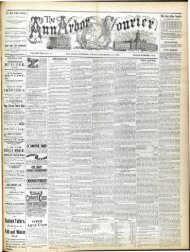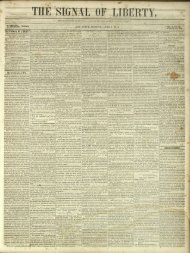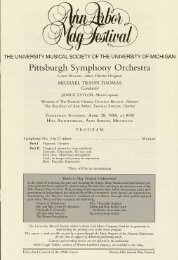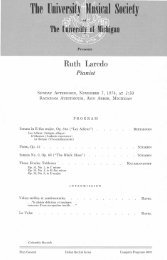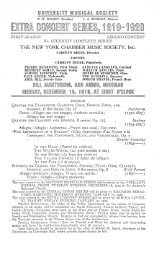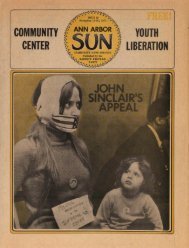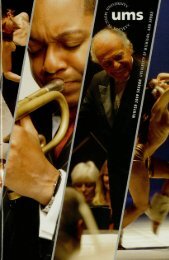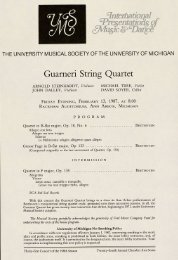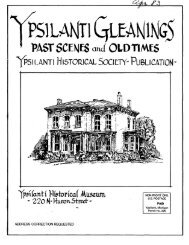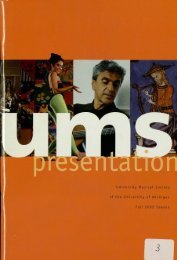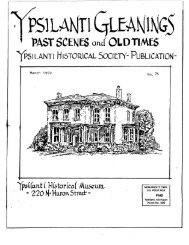Create successful ePaper yourself
Turn your PDF publications into a flip-book with our unique Google optimized e-Paper software.
UNIVERSITY MUSICAL SOCIETY<br />
<strong>Hungarian</strong> <strong>State</strong> <strong>Folk</strong> <strong>Ensemble</strong><br />
Sandor Timar, Artistic Director and Choreographer<br />
Erzsebet Nagy<br />
Domokos Szakacs<br />
Dance Directors<br />
Laszlo Berki<br />
Gypsy Orchestra<br />
Director<br />
Sandor Serfozo<br />
General Director<br />
Almos Caspar<br />
<strong>Folk</strong> Orchestra<br />
Director<br />
Friday Evening, February 11, 1994, at 8:00<br />
Power Center for the Performing Arts, Ann Arbor, Michigan<br />
Large print: programs are available aipom request from four usher.<br />
Tktny^ixlh Gamceirt of dbe 115th Seascan 23id Annual Choice Series
PROGRAM<br />
"Elindultam Szep Hazambol"<br />
("I was leaving my nice country")<br />
Throughout history, ethnic groups large and small have left their homeland in search<br />
of a better life, often to escape political persecution. Whatever the reason, leaving one's<br />
homeland is always a powerful emotional experience, Bela Bartok sang this song as he set<br />
off on his journey to America:<br />
Overture<br />
I was leaving my nice country,<br />
My beloved little Hungary. ,<br />
I looked back from half-way<br />
Tears came to my eyes.<br />
Pictures of Matyo .................. Laszlo Berki - Sandor Timar<br />
The region of Matyo is famous for its costumes and the rich treasury of folk dances the<br />
people have preserved. We open with the verbunk or "recruiting dance" and the csdrdds.<br />
Kalotaszegi Music .......................... Traditional<br />
Performed by the <strong>Folk</strong> Orchestra<br />
Play Dance of Sarkoz ......................... S. Timar<br />
From spring to autumn the young people of Sarkoz used to meet in the outdoor "play field"<br />
where the girls, dressed in colorful costumes, dance their circle dances which contain some<br />
of the oldest elements of European folk dance.<br />
Szegenyes and Pontozo ........................ S.Timar<br />
In some of the villages of the Kiikullo Valley in Southern Transylvania, this slow dance for<br />
men is called szegenyes ("poor"), while the rapid part of the dance is the pontozo ("quick<br />
steps").<br />
<strong>Hungarian</strong> Rhapsody No. 2 ..................... Franz Liszt<br />
Performed by the Gypsy Orchestra<br />
DanceWords ........................ L. Nagy - S. Timar ''<br />
The choreography of DanceWords is very different from the traditional forms of folk dance<br />
although the steps are derived from the dances of the Csango people of the Eastern<br />
Carpathian mountains. Musical accompaniment is replaced with the shouted poem supported<br />
by a stringed percussion instument known as a garden. The dancers wear ordinary street<br />
clothes, just as the young people did in the Dance Houses.<br />
Laszlo Nagy wrote this poem for the emerging <strong>Hungarian</strong> Tanchaz ("Dance House")<br />
movement. Young people in the early Seventies discovered that they could use the beauty
During the last few years, Mr. Timar has rebuilt this ensemble of young dancers,<br />
musicians and singers, who form the foundation for his new integrated presentation of<br />
<strong>Hungarian</strong> folklore. Some of the recently choreographed dances included in the new program<br />
reflect political statements about the importance of survival of the <strong>Hungarian</strong> culture. Mr.<br />
Timar was successful in establishing the new <strong>Hungarian</strong> <strong>State</strong> <strong>Folk</strong> <strong>Ensemble</strong> to reflect and<br />
emphasize the current political changes and the re-establishment of a free <strong>Hungarian</strong> nation.<br />
The <strong>Hungarian</strong> <strong>State</strong> <strong>Folk</strong> <strong>Ensemble</strong> was founded to revive and preserve <strong>Hungarian</strong><br />
folk music, song and dance and present them throughout the world. In 1990, the <strong>Ensemble</strong><br />
embarked on a triumphant tour of North America, following closely on the heels of their<br />
great success in 1984 and 1987. In 1984, 1987, and 1990, this spectacular ensemble toured<br />
coast-to-coast, hailed by critics in New York, Toronto, Washington DC, Philadelphia, Ann<br />
Arbor, Chicago, Los Angeles, and San Francisco a 12-week tour-de-force!<br />
Artistic Director Sandor Timar's brilliant company preserves true <strong>Hungarian</strong> folk<br />
elements with theatricality and spectacle. These 70 performers are the best in the world of<br />
their kind. Based in Budapest, the members of the company are hand-picked from the very<br />
best in Hungary, and have been chosen above all other <strong>Hungarian</strong> folk companies by the<br />
government to be its official representative abroad.<br />
The previous <strong>Hungarian</strong> <strong>State</strong> <strong>Folk</strong> <strong>Ensemble</strong>, under the Artistic Direction of Milos<br />
Rabai, also toured the U.S. and Canada in 1966, playing a four-week engagement in New<br />
York City. Since the death of Maestro Rabai, the ensemble has been completely reorganized<br />
under Sandor Timar.<br />
The extraordinary folk music that inspired Bela Bartok, Zoltan Kodaly and Franz Liszt<br />
is the foundation for the ensemble's panorama of breathtaking dance, sumptuous costumes,<br />
magnificent choral singing and intoxicating <strong>Hungarian</strong> folk and Gypsy melodies. Many<br />
people associate <strong>Hungarian</strong> folk music with that of the <strong>Hungarian</strong> Gypsy, and much of this<br />
type of music was written in the last century and made famous by many Gypsy orchestras.<br />
In addition, <strong>Hungarian</strong>s in isolated villages have introduced their own exciting folk music<br />
into the current culture.
of folk art to express their disapproval with the political situations through words, music<br />
and dance. The poem is dedicated to the Bela Bartok Dance <strong>Ensemble</strong> which was committed<br />
to the renewal and preservation of folk art traditions.<br />
I am good<br />
I am good enough for nobody<br />
1 am scolded on Earth and Heaven<br />
My feet are for dance<br />
Earth is as bad as Heaven<br />
1 would be good<br />
When I was allowed to be<br />
Let us to where we are needed<br />
Where we are happy to be<br />
Because the spirit sounds in us<br />
This life belongs to us<br />
Dances from Kibed .......................... S. Timar<br />
Kibed is a village in Transylvania where the people still observe ancient customs. The male<br />
dancers usually dance the verbunk, while couples still dance the slow and the fast csdrdds.<br />
INTERMISSION<br />
Dances of Magyarszovat ........................ S. Timar<br />
The people of the Transylvanian plains have preserved an amazingly rich music and dance<br />
heritage. The uniqueness of the traditional folk art of this region make these dances<br />
well-loved home and abroad.<br />
Dances of Udvarhely ....................... Laszlo Lajtha<br />
<strong>Hungarian</strong> Dance No. 5 .................... Johannes Brahms<br />
Performed by the Gypsy Orchestra<br />
Verbunk and Whirling of Bag ................ L. Berki - S. Timar<br />
The elderly women of the Galga region of Budapest still wear the orignial national costumes.<br />
The sprightly whirling dance has the characteristic bukos ("bent knees") element of<br />
<strong>Hungarian</strong> dance.<br />
The male dancers perfrom the fast csdsrdds with very deeply bent knees: this is extremely<br />
challenging for the dancers and quite extraordinary to see.<br />
Circle Dance of Slavonia ....................... S. Timar<br />
In the South Slavonian region, the women's circle dances derived from springtime rituals<br />
where, after Sunday mass during Lent, the girls would parade along the streets of the village<br />
singing and dancing.
Heyduck-Dance Memories or Shepherd Csardas ............ S. Timar<br />
Heyduck dances were 16th- and 17th'Century soldiers' dances. It is very probable that they<br />
influenced the crook dances of shepherds in the Carpathian Basin. The same forms and<br />
musical elements are present in <strong>Hungarian</strong>, Slovakian, Goral and Transylvanian folk arts.<br />
The choreography presents <strong>Hungarian</strong>, Gypsy, Slovakian and Romanian crook dances of<br />
the South Transdanubian and Upper Tisza regions as well.<br />
Shepherds eased the hardships of their lives by coming together to hold dancing competi<br />
tions. Their dances became ever more intricate and skillful when young girls would come<br />
to dance with them.<br />
Dances of Rabakoz ...................... L. Berki-S. Timar<br />
Trade unions played a considerable role in the preservation of folk traditions by organizing<br />
parish feasts where local men and boys would dance the verbunk. The favored dances were<br />
the ancient dus and the slow and fast csdrdds.<br />
Tour Direction: Columbia Artists Managment, Inc.<br />
John Luckacovic, vice president<br />
Maria Flotta, associate Melissa Jacobs, assistant<br />
Columbia Artists Management Staff<br />
Charles E. Lambertz, Company Manager Allison Spak, Production/Stage Manager<br />
Tibor Spak, Assistant Stage Manager Zoltan Spak, Special Projects<br />
Coach transportation by Anderson House<br />
Equipment transportation by Paramount Show Transportation<br />
Overseas transportation sponsored by Malev Airlines<br />
Produced in association with Interconcert, Budapest<br />
Special thanks for help and support to:<br />
Sandor Sallai of Interconcert<br />
Judith and Kalman Magyar<br />
Thomas Keller and his Travel Department<br />
Patrick O'Leary and his Tour Department<br />
ABOUT THE ARTISTS<br />
Sandor Timar was born in Szolnok, in Eastern Hungary, in 1930. He started dancing<br />
in grammar school and devoted his energies to learning everything possible about this art.<br />
In 1951 he became a professional dancer in the Trade Union <strong>Folk</strong> <strong>Ensemble</strong>. Later he<br />
organized his own company, The Bartok <strong>Ensemble</strong>, which gained fame in many countries.<br />
His further education at the College of Dramatic and Cinematic Art gave him the foundation<br />
for his choreographic talent, which is considered one of the foremost in Hungary. As Artistic<br />
Director of the <strong>Ensemble</strong>, he is responsible for selecting the best singers, dancers, and<br />
musicians from the many hundreds who eagerly apply. He has been the recipient of numerous<br />
prizes and awards in Hungary and abroad, and since 1971, he has been Director of the <strong>State</strong><br />
Ballet Institute in the area of folk dance. Maestro Timar was appointed Artistic Director of<br />
the <strong>Hungarian</strong> <strong>State</strong> <strong>Folk</strong> <strong>Ensemble</strong> in 1981. His name is a famous one among folk dance<br />
enthusiasts throughout the world and he has been decorated with the highly valued "Erkel<br />
Prize" in recognition of his choreographic work.
Throughout the world <strong>Hungarian</strong> folk culture is studied and practiced by folk groups of<br />
all nations who are interested, not only in their own, but in the traditions of other nations<br />
as well. In America, hundreds of <strong>Hungarian</strong> societies keep alive these traditions which<br />
enrich everyone and help promote greater understanding between people and nations.<br />
Maestro Timar has dedicated his professional career to the preservation of the true<br />
<strong>Hungarian</strong> folk culture. All of the dances performed by the <strong>Ensemble</strong> are authentic and<br />
date back hundreds of years. In more recent times, Sandor Timar has choreographed several<br />
dances, which reflect the political changes in Eastern Europe. One of these dances strives<br />
to establish the unity of spirit, heritage and cultural pride of <strong>Hungarian</strong>s living around the<br />
world. This unique presentation will be included in the <strong>Ensemble</strong>'s repertoire symbolizing<br />
the mission of the new <strong>Hungarian</strong> <strong>State</strong> <strong>Folk</strong> <strong>Ensemble</strong> traveling to America for the first<br />
time from a free and democratic land.<br />
Tonight's performance marks the <strong>Ensemble</strong>'s fourth UMS appearance.<br />
g 2 Supported by the Michigan Council for Arts and Cultural Affair*<br />
Pilar Rioja<br />
Tomorrow!<br />
February 12, 8 p.m.<br />
Power Center<br />
Extraordinary Spanish<br />
Dance.<br />
GLOBAL MOVEMENT<br />
Urban Bush Women<br />
March 11, 8 p.m.<br />
Power Center<br />
Powerful dance, story-telling,<br />
singing, and vocalizations.<br />
Call (313) 764-2538 for tickets.<br />
University Musical Society,<br />
Burton Tower, Ann Arbor, MI 48109-1270




